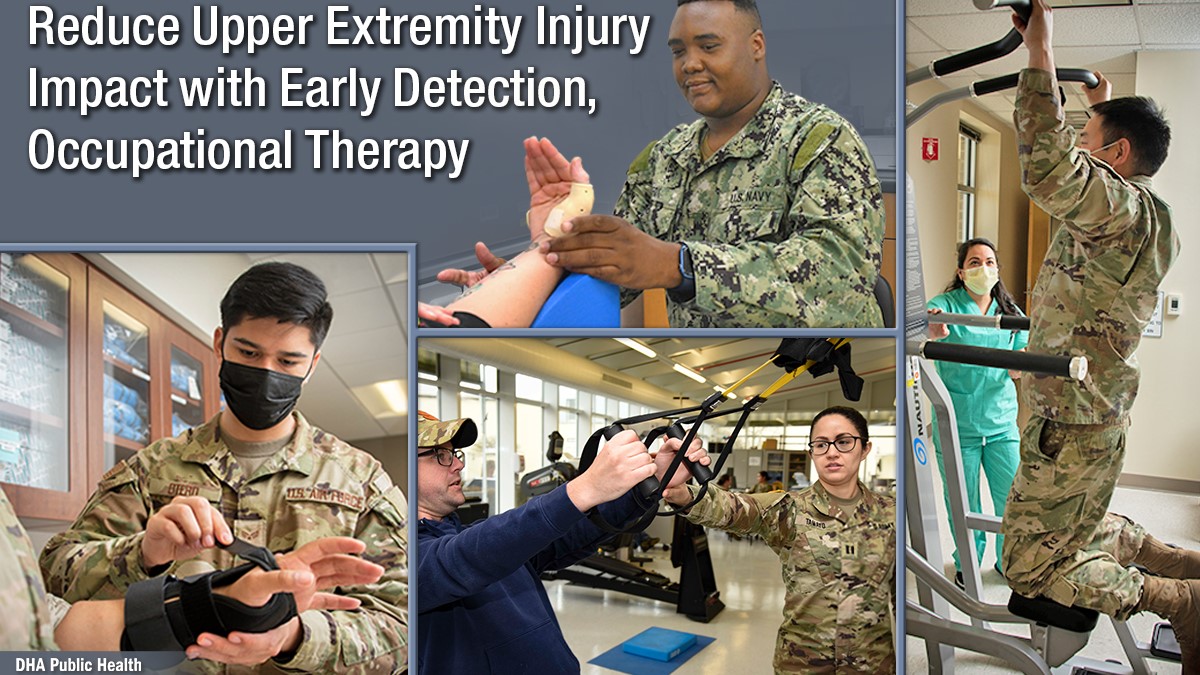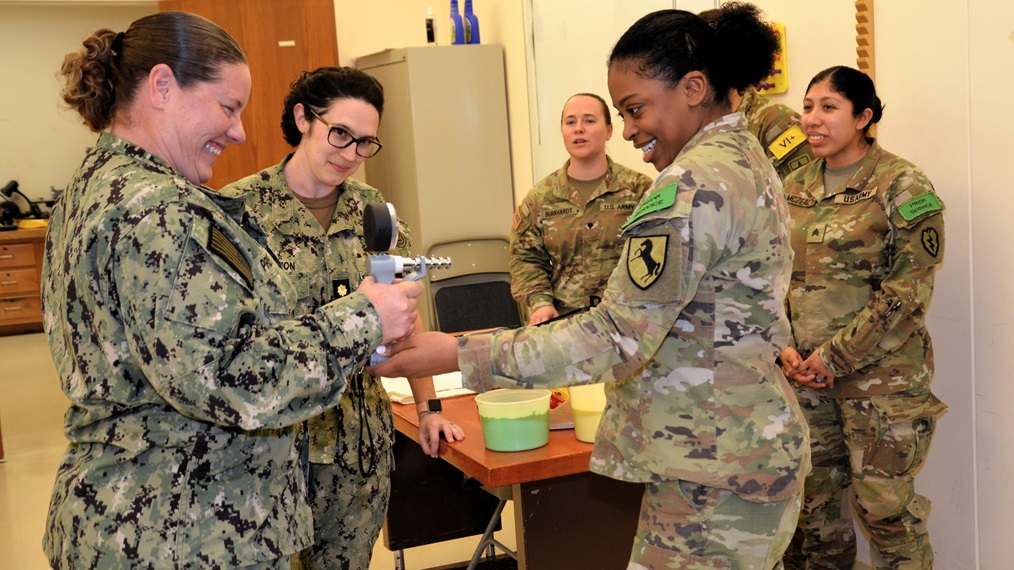April 10, 2025 | By V. Hauschild, MPH, Defense Health Agency-Public Health Public Affairs
Service members experience 25 million limited duty days annually due to injuries, most of which are musculoskeletal injuries, also known as MSKI.
When on limited duty status, a service member may not be able to maintain required training activities and may not be deployable. As a result, the combat readiness of the U.S. military forces is substantially reduced by MSKI, costing the Department of Defense billions of dollars annually. “For decades, the data have consistently shown that MSKI are the primary reason for service members’ medical visits,” says Dr. Bruce Jones, a retired Army physician and current senior advisor to the Defense Health Agency-Public Health Clinical Public Health and Epidemiology Directorate in Aberdeen, Maryland. “Though MSKI most commonly occur in lower body areas such as the knees, legs, ankles and feet, approximately 20% of all military medically reported injuries are to upper extremity areas, such as to shoulders, elbows, wrists, hands and fingers.”
Upper extremity injuries require unique recovery treatments that are most effective when tailored to an individual’s injury, as well as their specific work and personal activities. This treatment is provided by military Occupational Therapists Practitioners, known as OTPs, who are trained to treat service members’ upper extremity injuries from shoulders to fingertips. “The treatment of an upper extremity injury depends on many factors: how long ago the injury occurred, the overall health of the service member, and compliance with the treatment plan,” says U.S. Army Maj. Amanda Hetzler, an OTP currently assigned to DHA-Public Health in Aberdeen.
She points to evidence that early access to OT is the leading factor in reducing a patient’s recovery time. “The sooner we can start working with an injured service member, the better outcomes can be,” says Hetzler.
What are common upper extremity injuries?
Military injury data indicate that among the upper extremities, the shoulder is the most commonly injured body area.
Some units may be at higher risk of these injuries. For example, an analysis of medical data found that compared to other service members, military paratroopers have been treated for more acute shoulder injuries, such as fractures, sprains or dislocations of the shoulder or acromioclavicular joint (where the shoulder and collarbone meet). The data also showed paratroopers were more likely to develop shoulder overuse injuries than non-paratroopers. Shoulder injuries can be more severe and require a longer recovery period than lower extremity injuries.
While Hetzler says she also often sees acute, or single incident, pain injuries to the wrist or hand caused by a fall on outstretched hands while a service member is running and carrying gear, most injuries she has seen in the military population are the result of overuse.
Overuse injuries occur from a repeated, low-intensity force over time that damages tendon, joint, ligament, muscle and/or skeletal tissue, overwhelming the tissue’s normal ability to recover. Over two-thirds (69%) of military injuries are cumulative microtraumatic injuries that result from overuse.
Hetzler describes other upper extremity overuse injuries commonly treated by OTs:
- Thumb and wrist pain, including de Quervain's Tenosynovitis and Gamer’s thumb: Also sometimes called de Quervain's tendinosis or de Quervain's tendinitis, this condition occurs when thumb tendons become inflamed and cause pain and swelling at the base of thumb into the side of the wrist or lower arm. Symptoms can include numbness and/or a sensation that your thumb is sticking when you try to move it.
- Elbow and forearm pain, especially Lateral Epicondylitis: Also referred to as elbow tendonitis or sometimes tennis elbow, this condition causes pain in the affected forearm when you’re trying to complete ordinary movements such as gripping or holding even relatively light objects, turning knobs, driving, typing, or shaking hands.
What causes upper body injuries?
“Overuse injuries can be attributed to various activities that require repetitive motion such as pushing, pulling, and lifting and can also be impacted by ergonomics, tool use, and the overall strength and condition of a person,” says U.S. Navy Lt. Cmdr. Emmy Hartley, an OTP currently assigned to Naval Hospital Pensacola, Florida.
Some upper body diagnoses such as ‘Gamer’s thumb’ are commonly given due to the many cases in the U.S. that are caused by excessive use of video game remote control devices and cell phones. The term ‘tennis elbow’ is frequently used because of the popularity of racquet sports that contribute to repetitive strain on the wrist, causing the condition. Although the condition ‘tennis elbow’ may be diagnosed for service members, it is rarely caused by tennis play within the military population.
“More relevant to the military, evidence has shown that certain occupations that require intense repetitive physical activity, such as shooting rifles, performing mechanic work, or carrying objects during military tasks, can increase the risk of certain upper body injuries,” says Hartley.
In addition to unique mission activities such as paratrooper duties, Hetzler recalls patients describing some examples of triggering military activities:
- Pushups
- Weightlifting (especially ‘snatching,’ which involves taking a wide grip on a weighted barbell, pulling it off the floor rapidly, and lifting the barbell over the head with arms outstretched in one continuous motion, placing stress on the wrist.)
- Lifting of gear (loading and unloading)
“While these activities are often critical to military training or duties, the patient can often not perform them while injured,” says Hetzler. “In addition, a key part of most OT treatment plans will require a recovery period where these activities should not be performed.”
What can you do to minimize the impact of an upper extremity injury?
“The best way to reduce the impact of an injury is to prevent it from occurring. Most injuries, especially overuse injuries, are preventable,” says Jones. “Various military resources are available to help service members target key injury risk factors and improve service member readiness by reducing injury risk.”
These resources can help service members avoid injuries while maximizing fitness, and allow early accessibility to an OTP. For example, some Army units are including Holistic Health and Fitness, known as H2F, teams into their brigade formations, while Navy and Marine units have the Navy Operational Fitness and Fueling System, or NOFFS.
“If you develop a MSKI or experience painful symptoms not yet limiting you, seek immediate care,” says Hetzler. “With delayed care or a lack of proper intervention, injuries can result in reduced readiness of the unit, limited military career progression or worse—permanent disability.”
Hetzler and Hartley also highlight that OTPs can provide activity analysis of specific tasks, such as lifting, pushups, and body mechanics, while the task is being performed. These analyses result in preventive education and training that can further reduce the risk of MSKI.
“The most important step is early diagnosis and referral to an OT who will help develop and monitor your treatment plan. Especially, don’t ignore pain in joints,” says Hetzler. “Once you are under the care of an OT, of course, you need to follow the treatment plan. This is the best way to reduce your chance of a longer recovery or permanent condition.”
Additional information sources:
- Armed Forces Wellness Centers (AFWCs): https://ph.health.mil/organization/hpw/Pages/ArmyWellnessCenters.aspx
- Warfighter Physical Optimization Website: https://warfighterwellness.org/physical-wellness/
- Consortium for Health and Military Performance: Musculoskeletal Injury Rehabilitation and Recovery: https://rx3.usuhs.edu/
- DHA Military Injury information: https://ph.health.mil/topics/discond/ptsaip/Pages/default.aspx
- DHA Ergonomics information: https://ph.health.mil/topics/workplacehealth/ergo/Pages/default.aspx
The Defense Health Agency supports our Nation by improving health and building readiness–making extraordinary experiences ordinary and exceptional outcomes routine.
NOTE: The mention of any non-federal entity and/or its products is for informational purposes only, and is not to be construed or interpreted, in any manner, as federal endorsement of that non-federal entity or its products.




